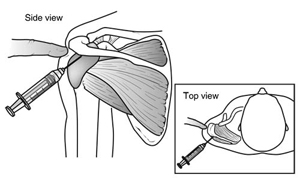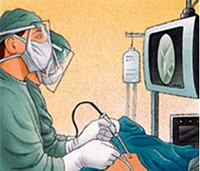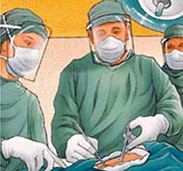Rotator Cuff Syndrome / Tendinitis (Part Three)
Treatment
The goal of treatment is to reduce pain and restore the function of the shoulder. In planning your treatment, the doctor will consider your age, activity level, and overall health.
Conservative Treatment
In most cases, the initial treatment is non-surgical. Although non-surgical treatment may take several weeks to months, many patients experience gradual improvement and return to function.
Rest: The doctor may suggest rest and modifying activities, such as avoiding activities like lifting your arms overhead.
Nonsteroidal anti-inflammatory medications. Drugs like ibuprofen and naproxen reduce pain and swelling.
Physical Therapy: Initially, a Physiotherapist will focus on restoring normal movements to your shoulders. Stretching exercises are useful for improving the range of motion. If you have difficulty bringing your arm behind your back, you may have developed tightening of the shoulder's posterior capsule. In such cases, specific exercises are needed to alleviate pain.
As pain improves, your therapist may start you on a program to strengthen the muscles of the rotator cuff.

Steroid Injection: If treatment with medications and physical therapy does not relieve your pain, an injection of a local anesthetic and a corticosteroid may be helpful. Cortisone is a very effective anti-inflammatory medication. Injection into the Bursa under the acromion can relieve pain.
Surgical Treatment
When non-surgical treatment does not relieve pain, the doctor may recommend surgery.
The goal of the operation is to create more space for the rotator cuff. To do this, the doctor will remove the inflamed part of the Bursa. They may perform an acromioplasty, in which a part of the acromion is removed, the part that plays the role of a hook by rubbing against the rotator cuff. This is known as a subacromial decompression. These procedures can be performed using arthroscopy or open surgery.
Arthroscopy Technique
In arthroscopy, thin surgical instruments are inserted through two or three small punctures around your shoulder. The doctor examines your shoulder through a fibroscope connected to a television device. Using small instruments and a video monitor, the doctor removes soft tissue and bone. In most cases, the front edge of the acromion along with a part of the bursa is removed.
 |
 |
| Arthroscopic Repair. | Open Surgery Procedure. |
The surgeon may also treat other shoulder problems during this time. These may include arthritis between the clavicle and the acromion (acromioclavicular arthritis), inflammation of the biceps tendon or partial tears of the rotator cuff.
Open Surgical Technique: In open surgery, the doctor will make a small incision at the front of your shoulder. This allows the doctor to see the acromion and the rotator cuff.
Rehabilitation
After surgery, your arm may be placed in a sling for a short period. This allows for early healing. As soon as you are comfortable, the doctor will remove the sling to start exercises and use of the arm.
The doctor will provide a rehabilitation program based on your needs and surgical findings. This will include exercises to regain the range of motion of the shoulder and the strength of the arm. It usually takes 2-4 months to be completely relieved from pain, but it may take up to a year.
Hello,
A few months ago, while I was tightening a screw with a screwdriver, I felt a stabbing pain in the upper part of my arm from the back, which caused me a lot of difficulty in moving my arm for a few days. Over time, the pain subsided, but since then, the pain occasionally returns and circulates in the shoulder area from the shoulder blade and other parts. I haven't visited a doctor yet, thinking it's something minor and temporary, but although there are days when the pain eases and then returns again. I would like some advice from you and what the approximate symptom might be.
Thank you
Sent by Xhevahiri, më 12 December 2014 në 05:34
My wife suddenly started experiencing unbearable severe pain in her shoulder. In fact, she has been having mild pains since January of this year but they went away. Despite seeing an orthopedic doctor who, after examining her at the military hospital, prescribed medications for relief and treatment, she has been experiencing continuous severe pain for 2 days now. Please advise us on what we should do to prevent her from suffering like this
Sent by Bujar skudrina, më 24 June 2015 në 07:51